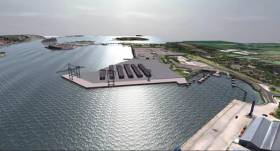Displaying items by tag: Cork Container Terminal
Port of Cork Company Celebrates Bumper First Year at Cork Container Terminal
Over 90,000 containers were loaded and discharged at the Port of Cork Company’s new Cork Container Terminal (CCT) in Ringaskiddy in what was a bumper first year at the state-of-the-art facility.
The Cork Harbour terminal, which is the result of a €94 million investment, became operational in April 2022 with an official launch on 23 September 2022.
In its inaugural year, 46,932 containers were discharged at CCT and 48,282 containers loaded onto a total of 340 ships which docked at the deepwater facility. On average, 280 containers were loaded and discharged per ship.
Commenting on CCT’s first year in operation, Conor Mowlds, the Port of Cork Company’s chief commercial officer said: “The launch of CCT last year was a hugely important milestone for the Port of Cork Company as it marked the culmination of years of significant planning, investment and development in this vital facility to ensure the port’s ongoing competitiveness.
“CCT represents the largest single investment in marine infrastructure of any Irish port over the last 100 years and has enabled the port to deliver more efficient container handling facilities, strengthening Cork’s position as an international gateway for trade.”
The container terminal in Ringaskiddy is one of the largest deep-water, multimodal berths in the world at 13 meters deep and 360 metres long.
The official opening of CCT was followed by another significant milestone for the company in May this year with the launch of the Port of Cork Masterplan 2050, which will see further development of the CCT site.
Among the key points in the masterplan, the company says that the delivery of the M28 will enable further relocation of its activities from Tivoli Docks to Ringaskiddy and unlock significant port capacity in the lower harbour.
Supporting the accelerated growth of the fixed offshore renewable energy (ORE) sector is another important component of the plan which charts a course to a new sustainable and secure future for the port.
Work Begins On New Cork Container Terminal
Maritime Journal reports that work has begun on the Port of Cork’s new Cork Container Terminal at Ringaskiddy.
Afloat.ie previously covered the development at its launch last June, where plans were revealed for its first phase of a 300-metre quay with 13-metre depth that will enable larger container ships to berth adjacent to Ringaskiddy’s existing RO-RO ferry terminal.
The €80 million project will also see construction of a 13.5 hectare terminal and associated buildings, plus two ship-to-shore gantry cranes and container handling facilities.
BAM Civil Ltd won the tender for the Cork Harbour development and commenced work on the site in late 2018, following a hiccup involving a reported ‘mistake’ in the tender sums.
























































